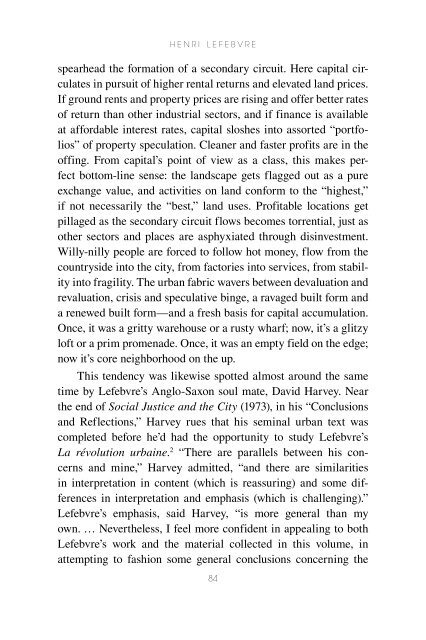Henri Lefebvre: A Critical Introduction - autonomous learning
Henri Lefebvre: A Critical Introduction - autonomous learning
Henri Lefebvre: A Critical Introduction - autonomous learning
Create successful ePaper yourself
Turn your PDF publications into a flip-book with our unique Google optimized e-Paper software.
H e n r i L e F e b v r e<br />
spearhead the formation of a secondary circuit. Here capital circulates<br />
in pursuit of higher rental returns and elevated land prices.<br />
If ground rents and property prices are rising and offer better rates<br />
of return than other industrial sectors, and if finance is available<br />
at affordable interest rates, capital sloshes into assorted “portfolios”<br />
of property speculation. Cleaner and faster profits are in the<br />
offing. From capital’s point of view as a class, this makes perfect<br />
bottom-line sense: the landscape gets flagged out as a pure<br />
exchange value, and activities on land conform to the “highest,”<br />
if not necessarily the “best,” land uses. Profitable locations get<br />
pillaged as the secondary circuit flows becomes torrential, just as<br />
other sectors and places are asphyxiated through disinvestment.<br />
Willy-nilly people are forced to follow hot money, flow from the<br />
countryside into the city, from factories into services, from stability<br />
into fragility. The urban fabric wavers between devaluation and<br />
revaluation, crisis and speculative binge, a ravaged built form and<br />
a renewed built form—and a fresh basis for capital accumulation.<br />
Once, it was a gritty warehouse or a rusty wharf; now, it’s a glitzy<br />
loft or a prim promenade. Once, it was an empty field on the edge;<br />
now it’s core neighborhood on the up.<br />
This tendency was likewise spotted almost around the same<br />
time by <strong>Lefebvre</strong>’s Anglo-Saxon soul mate, David Harvey. Near<br />
the end of Social Justice and the City (1973), in his “Conclusions<br />
and Reflections,” Harvey rues that his seminal urban text was<br />
completed before he’d had the opportunity to study <strong>Lefebvre</strong>’s<br />
La révolution urbaine. 2 “There are parallels between his concerns<br />
and mine,” Harvey admitted, “and there are similarities<br />
in interpretation in content (which is reassuring) and some differences<br />
in interpretation and emphasis (which is challenging).”<br />
<strong>Lefebvre</strong>’s emphasis, said Harvey, “is more general than my<br />
own. … Nevertheless, I feel more confident in appealing to both<br />
<strong>Lefebvre</strong>’s work and the material collected in this volume, in<br />
attempting to fashion some general conclusions concerning the<br />
4
















